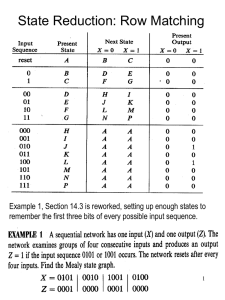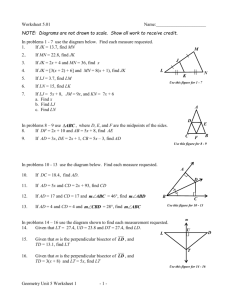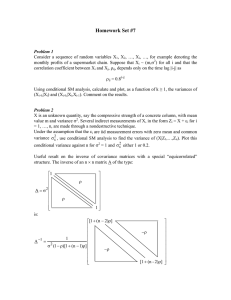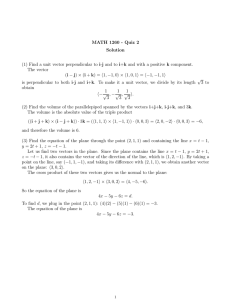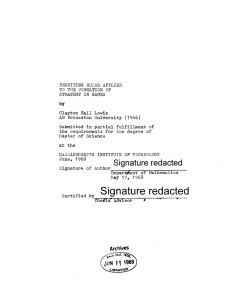Document 13134228
advertisement
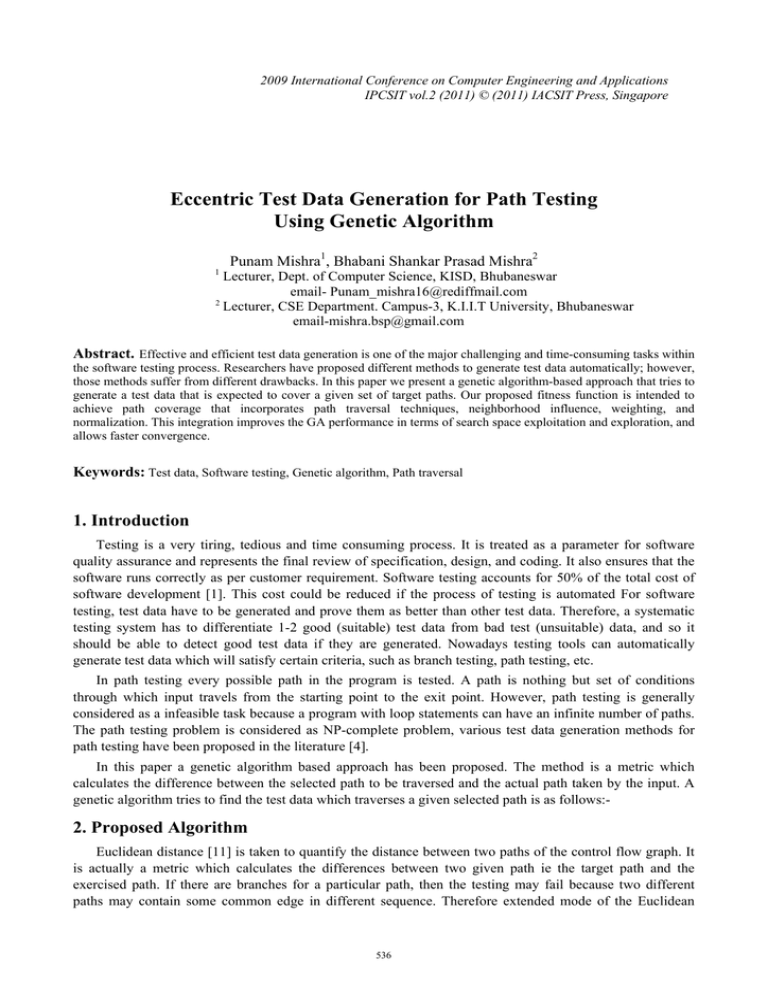
2009 International Conference on Computer Engineering and Applications
IPCSIT vol.2 (2011) © (2011) IACSIT Press, Singapore
Eccentric Test Data Generation for Path Testing
Using Genetic Algorithm
1
Punam Mishra1, Bhabani Shankar Prasad Mishra2
Lecturer, Dept. of Computer Science, KISD, Bhubaneswar
email- Punam_mishra16@rediffmail.com
2
Lecturer, CSE Department. Campus-3, K.I.I.T University, Bhubaneswar
email-mishra.bsp@gmail.com
Abstract. Effective and efficient test data generation is one of the major challenging and time-consuming tasks within
the software testing process. Researchers have proposed different methods to generate test data automatically; however,
those methods suffer from different drawbacks. In this paper we present a genetic algorithm-based approach that tries to
generate a test data that is expected to cover a given set of target paths. Our proposed fitness function is intended to
achieve path coverage that incorporates path traversal techniques, neighborhood influence, weighting, and
normalization. This integration improves the GA performance in terms of search space exploitation and exploration, and
allows faster convergence.
Keywords: Test data, Software testing, Genetic algorithm, Path traversal
1. Introduction
Testing is a very tiring, tedious and time consuming process. It is treated as a parameter for software
quality assurance and represents the final review of specification, design, and coding. It also ensures that the
software runs correctly as per customer requirement. Software testing accounts for 50% of the total cost of
software development [1]. This cost could be reduced if the process of testing is automated For software
testing, test data have to be generated and prove them as better than other test data. Therefore, a systematic
testing system has to differentiate 1-2 good (suitable) test data from bad test (unsuitable) data, and so it
should be able to detect good test data if they are generated. Nowadays testing tools can automatically
generate test data which will satisfy certain criteria, such as branch testing, path testing, etc.
In path testing every possible path in the program is tested. A path is nothing but set of conditions
through which input travels from the starting point to the exit point. However, path testing is generally
considered as a infeasible task because a program with loop statements can have an infinite number of paths.
The path testing problem is considered as NP-complete problem, various test data generation methods for
path testing have been proposed in the literature [4].
In this paper a genetic algorithm based approach has been proposed. The method is a metric which
calculates the difference between the selected path to be traversed and the actual path taken by the input. A
genetic algorithm tries to find the test data which traverses a given selected path is as follows:-
2. Proposed Algorithm
Euclidean distance [11] is taken to quantify the distance between two paths of the control flow graph. It
is actually a metric which calculates the differences between two given path ie the target path and the
exercised path. If there are branches for a particular path, then the testing may fail because two different
paths may contain some common edge in different sequence. Therefore extended mode of the Euclidean
536
distance is used. it is derived from Pythagoras theorem. Euclidean distance in two dimensional forms is
given by:
Let P and Q be two points in Euclidean space
P=(p1,p2,……….pn)
and
Q=(q1,q2,…..qn),then distance is calculated as:
( p1 − q1)2 + ( p2 − q2)2 +........+ ( pn− qn)2 =
n
∑( pi− qi)n
i=1
Normalized Euclidean distance is used so that values will always lie between [0,1].
Normalized Euclidean distance = Euclidean distance/range [12]
Now we can define a fitness function CLOSENESS=1-(normalized Euclidean distance)
1.1 Cascaded branch testing:
Let G= control flow graph
P={pathi │ pathi is a complete path within G}= { path1, path2, path3…….., pathz}
N=number of complete path of p.
Let
S11= {g:g branch of path1}
S12= {h:h is a cascaded branch of path1}
S1n= {k:k is a n-tuple cascaded branch of path1}
Continuing like this……,
.Sqt={r:r is a t-tuple cascaded branch of path q}
First order distance:
Di-j1=√(x1-y1)2+(x2-y2)2
Ni-j1=Di-j1 ⁄range
D i-j 2=N i-j 2=D i-j 2 /range
Continuing like this……..,
.D i-j m=N i-j m=D i-j m /range
M i-j m=mth order closeness between i and j
M i-j m=0 or N i-j m=1 if path i and path j have no common branches
When N i-j 1=1,N i-j 2=1…………N i-j n=1
or
M i-j 1=0,M i-j 2=0……………..M i-j n=1
It results in worst test case generation
When N i-j 1=0, N i-j 2=0…………N i-j n=0
Or
M i-j 1=1, M i-j 2=1……………..M i-j n=1
It results in best test case generation
CLOSENESS can be computed as:
M i-j 1*w1+ M i-j 2*w2+ M i-j 3*w3+……… M i-j n*wn
Where w=weighing factor which are chosen with experience
If CLOSENESS i-k >CLOSENESS i-j, then path k is much closer to target than path j.
537
3. Basic steps of path testing
1.
2.
3.
Construction of control flow graph
Target path selection
Test data generation from the genetic algorithm and execution [6].
Fig. 1: Basic steps of test data generation.
For the testing process, triangle classifier problem is taken as a problem. the c code for triangle classifier
problem is as follows:
# include<string.h>
Char path[256];
Int triangleA(unsigned int a,unsigned int b,unsigned int c)
{
int triangle=0;
if((a+b>c)&&(b+c>a)&&(c+a>b))
{
strcat(path,”u”);
If((a!=b)&&(b!=c)&&(c!=a))
{
strcat(path”y”);
Triangle=1;
}
else
{
strcat(path,”v”);
if(((a==b)&&b!=c))||((b==c)&&c!=a))!!((c==a)&&a!=b)))
{
Strcat(path,”z”);
Triangle=2;
}
else
{
strcat(path,”x”);
Triangle=3;}
}
}
}
else
strcat(path,”w”);
return(triangle);
}
538
Control flow graph construction:
Fig. 2: Control-flow graph.
4. Conclusion
From the above discussion about genetic algorithm, we can conclude that genetic algorithm is used to
generate test data automatically. The greatest merit of using the genetic algorithm is its simplicity. The
proposed fitness function CLOSENESS is very simple and can enhance the speed.
5. References
[1]. B.Beizer.Software Testing Techniques,Van Nostrand Reinhold,2nd edition,1990.
[2]. B.Korel.Automated Software Test data Gneration.IEEE Transaction on Software Engineering 16(8);870879,August 1990.
[3]. Jon Edvardsson. A survey on automatic test data generation .In proceedings of the second conference on computer
science and engineering in Linkopinng, pages 21-28,ECSEL,October 1999.
[4]. Bruno T.Abreu,Eliane Martins,Fabiano L.deSousa.Automatic test data generation for path testing using a new
stochastic algorithm.Supported by Brazillian CNPq council through Reasearch Grant 134107/20047
[5]. Roy P.pargas,Mary jean Harrold,Robert R.peck.test data generation using genetic algorithm.journal of software
testing,verification and reiiability.1999,wiley copy right.
[6]. lin,j and yeh,p.(2001).using genetic algorithm for test case generation in path testing. information sciences,vol131,2001 pp 47-64.
[7]. philmcminn.Search-based software test data generation.A survey published in software testing,verification and
reliability 14(2),pp 105-156 june 2004,copy right(c) wiley 2004.
[8]. Sthamer ,H(1996).the automatic generation of software test data using genetic algorithm,phd thesis,university of
glamorgan pontyprid,wales,Great Britain.
[9]. D.goldberg.genetic algorithm in search,optimization and machine learning.addision-wesley,
reading,Massachusetts,1989.
[10]. Yong chen,Yong Zhong.automatic path-oriented test data generation using a multipopulation genetic
algorithm,Fourth International conference on Natural computation.IEEE computer society 11-566-569.
[11]. F.fessant,P.Aknin,L.oukhellou,S.Midenet.Comparision of supervised self organizing maps using Euclidean or
Mahanalabis distance in classification context ,6th international work conference in artificial and natural
network(IWANN 2001),Granada,june 13-15,2001.
[12]. Killian q.weinberger,Lawerence Kaul. Fast solvers and efficient implementation for distance metric
learning.preliminary work under review by the international conference on machine learning.
539
